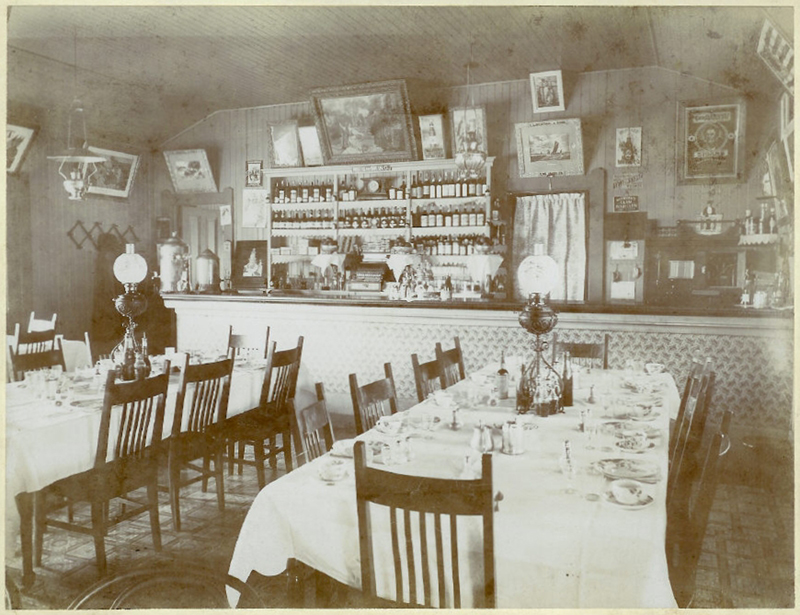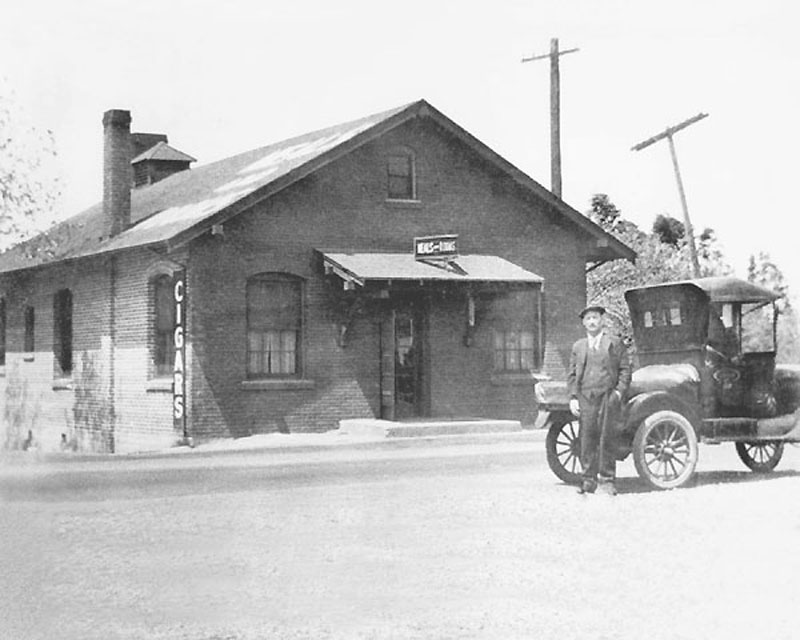|
|
Tales of the Saugus Café.
Rev. 2019.
|
Within the meandering boundaries of the City of Santa Clarita, only one business can claim to have been around longer than the Saugus Café — The Newhall Land and Farming Company. The story of the restaurant began in 1888 with the construction of the Saugus train station.[1] Named for the birthplace of Henry M. Newhall in Massachusetts, the curious term, "Saugus," is Narragansut Indian, meaning a sandy spit of land. James Herbert Tolfree[2] started the Saugus Eating House in the north end of the depot, also running a restaurant at Mojave Station[3,4].
A Southern Pacific Railroad employee, Richard R. Wood, with mining interest near Sacramento, arrived at Saugus in 1898, taking an option on the eating house and a chunk of land (Tract 1801) west of the railroad tracks. On January 18, 1899, his brother, Martin, came up from Terminal Island, co-signed the deed from Tolfree[5], altering the name a bit to Saugus Café. Martin took active management, not joined by Richard (Dick) for another seven years. The only building in Saugus at the time was the depot with the exception of a possible blacksmith shop up at the corner of present Magic Mountain and San Fernando Road. Helen Wood Cone later recalled local cowboys, bored with nothing to do, taking "pot shots" at the station and using north bound trains for target practice. According to local legend, President Theodore Roosevelt stopped by in May of 1903, dinning on a special New York steak, which he supposedly declared to be "splendid." On September 5, 1904, the indomitable chief of Los Angeles Department of Water and Power, William Mulholland and former Mayor Fred Eaton enjoyed a breakfast on their way to inspect the liquid assets of the Owens Valley. Driving a rickety buckboard, they had spent a hard night of drinking in a Newhall saloon before heading northward on a mission that would have far reaching consequences on the development of L.A. County. Martin Wood became a full time resident of Saugus in 1905. Richard Wood took a greater interest in the blacksmith shop which would become a garage and gas station. The brothers built residences for their families, a small rooming house and general store. A year later Ore W. Bercaw became master of the depot and post office, changing the name of Surrey. Bercaw developed the Surrey Inn, Ice House, Garage and Bercaw Store, south of the Wood's holdings.
During the fall of 1907, William Mulholland returned, setting up a construction camp for the Los Angeles-Owens Valley Aqueduct, pumping a lot of city money into the local economy. The café moved out of the train station in 1916 and across the tracks to, roughly, where it stands today.[6] The region was becoming a favored film making location. Here came fabled directors such as John Ford and D.W. Griffith for lunch or dinner. Doug Fairbanks, Mary Pickford and Charlie Chaplin stopped by in 1919. Harry Carey, who had a 3,000 acre ranch in San Francisquito, Hoot Gibson, owner of a rodeo arena, now Saugus Speedway, and William S. Hart were frequent guests. In 1926 Helen Wood married Bryon Cone, the couple running the eatery for the following decade. On March 12, 1928 the St. Francis Dam collapsed killing 450 people. With all utilities cut, the Cones drew hot water from a nearby locomotive providing much needed coffee for rescue workers. Tom Vernon[7] derailed and robbed a train November 10, 1929, escaping in a car he "borrowed" from Wood's Garage. During the 1930's Clark Gable, Gary Cooper, John Wayne and Tom Mix were served at the spacious booths. Marlene Dietrich filmed "Seven Sinners" behind the restaurant (1938). Fielding S. Wood took over management from the Cones in 1936, hitting on the idea of a "fast food" annex attached to the café. The first customer in 1941 was an out of control trucker who demolished the place. Fielding's home, by the way, was the Spanish style structure at Magic Mountain and San Fernando Road., that is now a small business. Judge Clarence MacDougall held the distinction of being the last Justice of the Old Soledad Judicial District and fist Judge of the Newhall Municipal Court. His wife, Olive, was descended from the Woods, and they ran the café during the '40s. "Judge Mac" actually courted the comely Olive at the Saugus Café counter. The couple sold out to Bill Rolls in 1952, ending a 54 year tradition of the café being in the hands of the same family. The venerable establishment had been closed for some time, Rolls tearing it down to erect a new Saugus Café a few feet southward. No less a personality than Frank Sinatra arrived in town in 1954[8] to make a feature film, "Suddenly" with Sterling Hayden. While not a memorable movie, it provides a near documentary look at Newhall and Saugus in the early '50s. A member of the Wood family returned in 1964 when Frank Cone took over the Rolls continuing the heritage of find food and service. Aside from the comings and going of celebrities, the café has always been a gathering place for locals discussing the affairs of the day. Robert (Bobby) and Florence Chesebrough reviewing cattle prices with the Lombardis, Andy and Camille Jauregui planning rodeo events with Sam and Rudy Garrett. Country music was the big topic between Tex Ritter and Cliffie Stone. Fred Kane took over in 1974, selling out to Steve Hwang a mere 5 years later. Hwang ran into financial problems, shutting the place down in November of 1983. For a brief period Hand Arklin and Coast Thrift and Loan hassled over ownership, the place finally winding up back in the hands of Fred Kane who liquidated the outstanding debts and put the Saugus Café back on fairly firm financial foundation. On February 1, 1994 Karen and David Nardiello acquired the property, starting a renovation that modernizes the restaurant while, at the same time, preserves its colorful past. While hard riding cowpokes are no longer expected to shoot-up the eatery and train robbery seems to be a thing of the past, The Saugus Café will continue serving bountiful meals at reasonable prices in a "down home" atmosphere. As far as the stars are concerned, they still come. Whoopi Goldberg and Drew Barrymore shot part of a film in its halls on March 18, 1994. Nowhere else in the valley can one dine with old friends, run across film legends, all within the walls fairly reeking with history.
Notes. Much information has come to light since Reynolds wrote this story in the early 1990s, when there was no public Internet and the sharing of local information was largely limted to current Santa Clarita Valley residents. Reynolds' original "as written" version survives in the physical archives. This online version has been updated with "new facts" that have come to light. 1. Reynolds wrote that the story starts "on September 1, 1887 with the dedication of the Saugus Train Station." While it's correct that the SPRR Saugus-Ventura line was dedicated in 1887, and that the café started inside the depot, it turns out that the depot was built in 1888. 2. In 2005, we were contacted by Beth Tolfree, wife of Charles H. Tolfree, who informed us that the "J.H." Tolfree who ran the eating house was Charles' great uncle, Joseph Herbert Tolfree. However, he was not the J.H. Tolfree who founded the diner; that was James Herbert, as shown in the news reports relating to the death of J.H. Tolfree in 1897 and the correlation to his grave marker as seen here. It is plausable that Joseph H. Tolfree ran the Tolfree diners after the death of James Herbert. Beth Tolfree also said Joseph Herbert had a brother, James Hamilton Tolfree, and that he was not involved in the business. 3. He also ran an eating house at Bakersfield, as well as the restaurant inside the Nadeau Hotel in Los Angeles. 4. Here, Reynolds states that on April 25, 1891, President Benjamin Harrison, "while on whistle stop re-election campaign, was served a meal as he waited for a delegation from Santa Barbara." In fact, Harrison did not stop at Saugus on that day or any other day. (The correct date was April 24; it was reported in the newspapers on the 25th.) The delegation from Santa Barbara had initially planned to meet him at Saugus but ultimately met him at San Buenaventura (Ventura). Harrison stopped at San Fernando and Santa Paula. 5. Founder James Herbert Tolfree had died two years earlier; thus, in his instance, "Tolfree" must refer to a successor within the family, quite possibly with the same intials, as noted in fn.2 above. 6. Research by Jean-Guy Dube. The café moved out of the depot in 1916; the depot was remodeled to its present configuration in 1917. 7. Reynolds identified him as "Buffalo" Tom Vernon. This was an unwitting amalgamation of two different people. The robber was Thomas Vernon. "Buffalo" Vernon was somebody else; in fact, it was an identity that was stolen by Thomas Vernon and reported as fact in newspapers and pulp magazines throughout the 20th Century. Only in the 2010s were we able to sort out the robber's true identity, primarily through prison records. 8. Reynolds wrote, "in 1953." Filming in Newhall and Saugus took place in April 1954.
|
Tales of the Saugus Cafe (Reynolds)
Envelope 1890
Dining Room & Letterhead 1890s
Harrison Passes By 1891
J. Herbert Tolfree
Charles Edward Tolfree
In Saugus Depot 1890s
Pottery Sherd 1891/1905
Replacement China
Advertisement 1895
J.H. Tolfree Death
1-16-1897
1914
Matchbook Cover 1938
Sandwich Shop Destruction 1941
Both Buildings 1955
Both Bldgs ~1957 x3
|
The site owner makes no assertions as to ownership of any original copyrights to digitized images. However, these images are intended for Personal or Research use only. Any other kind of use, including but not limited to commercial or scholarly publication in any medium or format, public exhibition, or use online or in a web site, may be subject to additional restrictions including but not limited to the copyrights held by parties other than the site owner. USERS ARE SOLELY RESPONSIBLE for determining the existence of such rights and for obtaining any permissions and/or paying associated fees necessary for the proposed use.
















